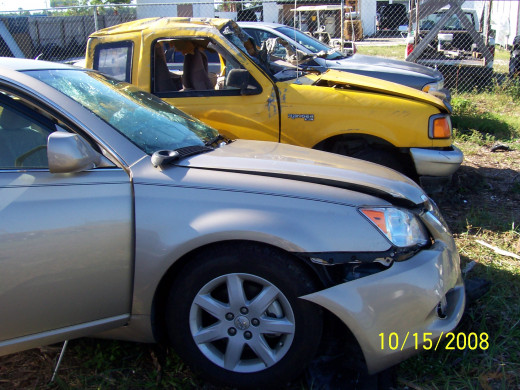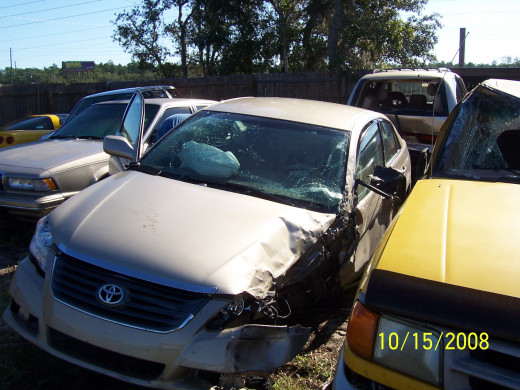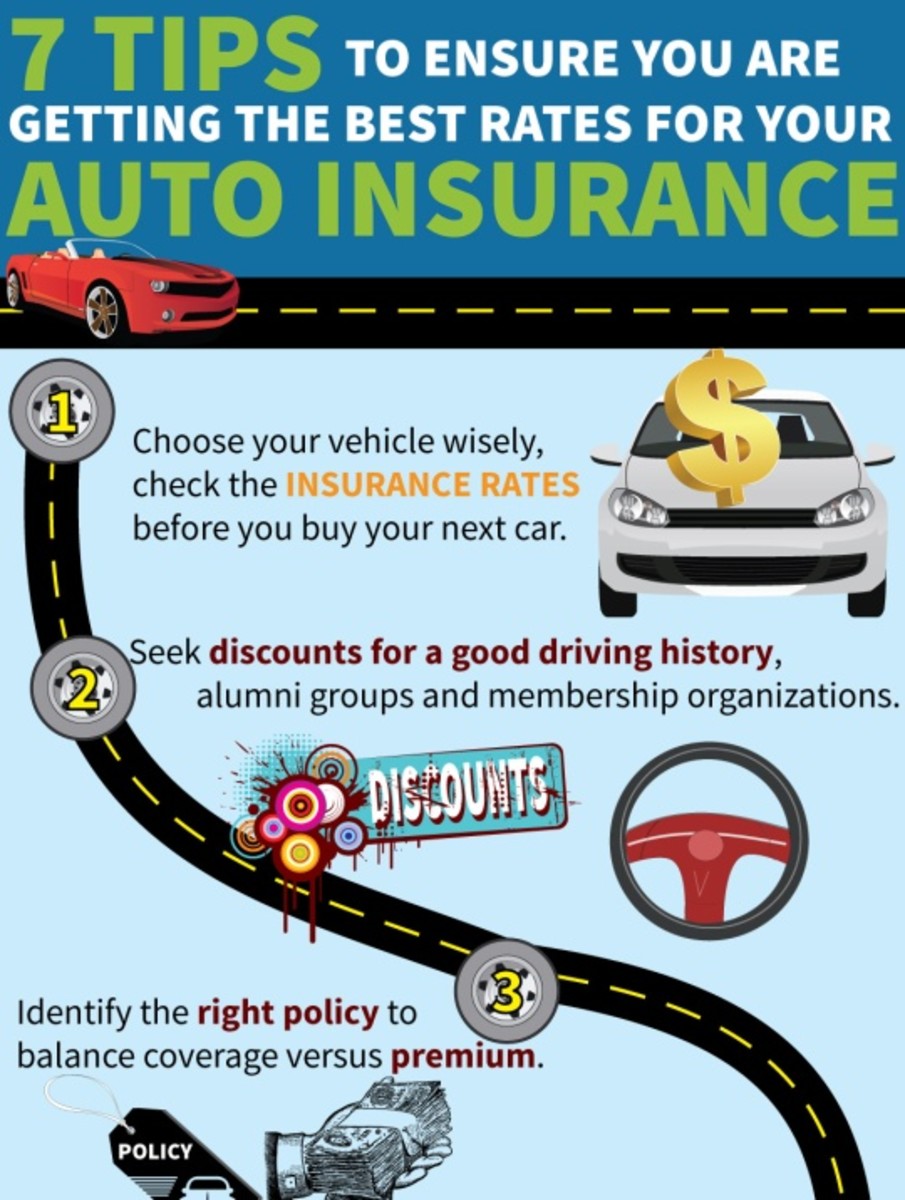Car Insurance: Having the Right Coverage
True Story of an Accident in Florida

According to the National Highway Traffic Safety Administration, in 2011 alone, there were 5.3 million motor vehicle traffic crashes; 2.2 million people were injured; and over 32,000 were killed, with half of the fatalities resulting from the failure to wear a seat belt. Given these statistics, it is imperative to review one's auto insurance policy annually in order to have the best possible coverage.
Working with personal injury firms (both plaintiff and defense) taught me so much about car insurance and claims. I cannot begin to tell you how many car accident cases I worked during my tenure at both firms. My mother and my uncle spent their careers as insurance agents; and, of course, I have my own experiences with car accidents and insurance claims. But the average person doesn't know a lot about car insurance, they just know that they need to have it when purchasing or registering a vehicle or get it to avoid being personally sued in the event of an accident.
The problem is that most people get the least amount of insurance based on state minimum requirements or by going as cheap as they can. Especially, since nationwide the trend has been rising insurance rates, according to the Insurance Information Institute.
Getting the Most Bang for Your Buck
But people need to know that there are much more important issues than meeting state minimums or keeping insurance cheap. It's important to include different types of coverage so you can get the most out of your car insurance. Rather than getting the cheapest insurance, one should have the most insurance he or she can afford.
True Story cont.

Making Decisions About Coverage
The major purpose in getting insurance in the first place is to protect yourself and your property from liability in the event of an accident. It is devastating to be involved in a catastrophic accident and not have the right coverage to pay for one's own losses or the losses, damages and injuries to others. Do not count on the other party to have enough insurance to cover you! In fact, approximately one-third of accidents DO NOT involve two or more vehicles. In other words, we get into accidents all by ourselves. (Singletary).
It's important to regularly review one's insurance policy to maximize the policy value. Use the Declarations Page of the auto insurance policy to compare it with the important tips provided below:
Five Important Tips to Get the Right Car Insurance
1. Bodily Injury Liability - Each person/Each Occurrence - Also known as BI, this protects against bodily harm to a person including resulting sickness or death as a result of the accident. The limits are listed on the Declarations Page. For example: each person/each occurrence 30,000/$60,000 means that no matter how many people are injured in the accident, each person injured will get up to $30,000 with a $60,000 cap per occurrence from the insurance company and no more.
This begs the question: what if someone has an injury which exceeds $30,000? Well, the insurance company will not pay. That means the injured person has the right to go after the policy holder personally for the excess.
True story: I recall an instance where an injured party sued the policy holder because the BI coverage, which was $50,000, was not enough to cover the $200,000 in damages related to a lost limb. The court approved a settlement in the injured person's favor. Needless to say, the policy holder that was "under-insured" was set up to pay the $150,000 difference in monthly payments over a five-year period.
Have a conversation with the insurance company to increase the BI coverage to the most coverage you can afford.
4. Collision Coverage- Make sure there is enough collision insurance on the vehicle to replace your car in the event it is totaled (at least blue book value if it is a used car). In the event the vehicle is secured by a loan, there must be enough to cover the balance owed in the event the vehicle is deemed a total loss. This may require an additional policy for GAP insurance.
Many times the insurance company will only pay the blue book value of the car, which may be less than the loan, particularly in the case of a new car purchase. In one related example, a policy holder had collision coverage on a new car. Two months after purchasing the car, it was totaled in an accident. The insurance company paid $12,000 (blue book value); however the balance of the loan amount was $14,000. The policyholder had to come out of his pocket and pay the $2,000 balance on the loan.
Many people who do not have car loan payments fail to have collision coverage in order to keep down their rates but the problem arises: if the vehicle is not covered by collision coverage, the insured will not receive payment for the loss. A good rule of thumb is this: If the car was totaled in an accident, would I have enough of my own money to replace it?
3. Personal Injury Protection - PIP - Check the Declarations Page to ensure PIP coverage. A number of states require drivers to have PIP on their insurance; other states do not. Just because it is not required by law does not mean it is unnecessary.
Available amounts of PIP coverage vary (depending on the insurance company). Get the most PIP you can afford or the maximum available through the insurance company. PIP covers medical expenses, funeral expenses,lost wages (as much of 80% of loss of income from employment), and other damages.
Unfortunately, so many people have not protected themselves in this way. Not only is the injury itself detrimental but any injuries that result in lost wages can be devastating for the family. It is a way of having some type of short-term disability coverage.
2. Medical Payments Coverage - Also known as MedPay - MedPay protects the insured and any family member occupying the vehicle at the time of the accident. The amount of coverage you purchase will pay reasonable expenses incurred for necessary medical and funeral services because of bodily injury.
MedPay insurance is optional under most insurance policies. Most people believe it is unnecessary because they already have medical insurance. But if your medical insurance has a deductible or a catastrophic cap, or won't pay at all because the medical bills should be paid by an auto insurance company, then having MedPay can make a difference.
Med/Pay is usually available at different levels even up to $100,000 and typically cover doctor visits, hospital visits and/or stays, surgery, x-rays, EMT & ambulance fees, professional nursing service and care, prostheses, and funeral costs. However, if the injured insured is eligible for Worker's Compensation, then MedPay will not cover the expenses to avoid "double dipping."
Most MedPay coverage will pay a supplementary death benefit to the insured's beneficiary if the insured was wearing a seat belt or protected by an airbag. There is usually a limit on this death benefit. Most insurance companies limit MedPay to $10,000.
Share your experience
Does Your Policy Include UM/UIM?
5. Uninsured/Under-Insured Motorist Coverage - Protection under UM/UIM is critical to protect oneself and his or her passengers. The truth is that some drivers carry the bare minimum insurance, or, even worse, carry no insurance.
UM/UIM is mandatory in some states but not all. In the event of an accident, when one party is underinsured or uninsured, then by having UM/UIM insurance, the damages will be paid under one's own policy. The explanation under BI coverage applies here. Still, even if one has UM or UIM, that does not preclude a personal civil suit against the at-fault party. (Insurance.com).
Other types of insurance coverage
Other types of coverage one might consider are:
- emergency roadside assistance
- new car replacement
- rental reimbursement
- mechanical breakdown.
Discounts
Depending on the insurance company, a number of discounts are available to reduce car insurance rates. This is the way to save on insurance rather that weakening the coverage. Insurance companies offer discounts based on:
- your daily mileage or average annual mileage
- anti-lock brakes
- anti-theft devices
- airbags
- good driving records
- good grades in school (for high school and college students)
- no DUIs, and
- defensive driving courses.
Contact your insurance company to take advantage of these discounts.
What is my insurance rate?
8 factors determine your auto insurance rates:
- Your driving record.
- How much you use your car.
- Where your car is parked and where you live.
- Your age.
- Your gender.
- The car you drive
- Your credit.
- The type and amount of coverage.
(Insurance Information Institute).
Accident Forgiveness
Some worry about increased insurance rates for having car accidents. This is totally normal. More insurance companies are providing Accident Forgiveness for their customers. It makes sense though; I mean, we get insurance because of the risk of being involved in an accident.
A number of insurance company offer accident forgiveness programs including Allstate, Liberty Mutual, and Geico. Geico provides accident forgiveness for those who have been Geico clients for at least five years and are accident free. Be careful about switching companies just to get a lower premium, lower rates could equal less coverage. Furthermore, accident forgiveness "is not a blanket pardon. Accidents often won't disappear from your driving record, which means a new insurer may include in its premium calculation incidents that formerly were "forgiven." (Glazer).
Be Safe
Take the time to review the policy annually with the auto insurance company to ensure maximum coverage to stay protected. Remember drive defensively; and don't drive under the influence of drugs or alcohol. Speeding tickets, other traffic violations, DUIs, and additional drivers will increase your rates. Stay safe and take steps to protect yourself.
Works Cited
Glazer, Emily. "Forgiveness is an Option." The Wall Street Journal. Aug. 18, 2012. http://www.wsj.com/articles/SB10000872396390444318104577587304179341554
Insurance.com. "Uninsured motorist coverage: Why you need it." Aug. 19, 2014. http://www.insurance.com/auto-insurance/explained/why-you-need-uninsuredunderinsured-motorist-coverage.aspx.
Insurance Information Institute. "What Determines the Price of My Auto Insurance Policy?" 2014. http://www.iii.org/article/what-determines-price-my-auto-insurance-policy.
National Highway Traffic Safety Administration. "Traffic Safety Facts: 2011 Data." http://www-nrd.nhtsa.dot.gov/Pubs/811753.pdf.
Singletary, Michelle. "When buying car insurance, compare rates and don't underestimate needed coverage." The Washington Post. Feb. 15, 2013. http://www.washingtonpost.com/business/when-buying-car-insurance-compare-rates-and-dont-underestimate-needed-coverage/2013/02/14/ea4d879a-756a-11e2-aa12-e6cf1d31106b_story.html.
By Liza Lugo, J.D.
Copyright © 2013, Revised 2014.. All Rights Reserved.
Ms. Lugo retains exclusive copyright and publishing rights to all of her articles and photos by her located on Hub Pages. Portions of articles or entire content of any of these articles may not be used without the author's express written consent. Persons plagiarizing or using content without authorization may be subject to legal action.
Permission requests may be submitted to liza@lizalugojd.com.








